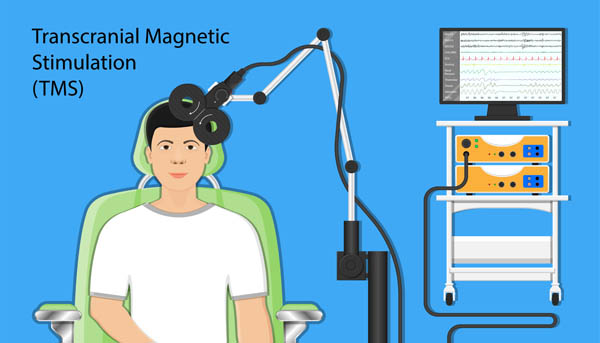Why TMS Is a High Quality Treatment for Depression

TMS or transcranial magnetic stimulation is a depression therapy for treatment-resistant depression. This condition can disrupt one’s life in so many ways. Treatment can be a slow process with conventional treatment. That is why doctors resort to a faster alternative treatment. If you want to know why TMS is a high-quality treatment for depression, here are the details.
Does not have terrible side effects
Taking antidepressants often leaves the patient with several side effects. Appetite loss and insomnia are two of the most common side effects of these medications. Electroconvulsive therapy can come with side effects like memory loss and convulsions. This aggressive method needs sedatives or anesthesia to make it painless.
TMS is a painless and quick procedure. The patient can go back to daily activities after the session. An average patient can get about five sessions each week for about seven weeks. This completes the treatment series for each patient. TMS can reduce depression symptoms by the end of the series.
Provides a long-term solution
TMS is an effective depression treatment. A patient will only need one therapy series to get optimal results. Doctors often tell their patients to come in for a checkup every six months after the treatment. The checks enable the doctor to keep an eye on the patient’s progress. Some individuals experience complete relief for years. Additional treatments are only necessary for any future need.
Removes the need for antidepressants
This treatment can remove the need to take antidepressants, which can lead to severe side effects. Taking these medications can also lead to dependency. TMS with psychotherapy gives patients complete treatment for depression. Most people experience this type of relief from years of depression.
Has few side effects
It is common for patients to have headaches during and after a TMS session. The pain often fades in one week. This treatment concentrates on one specific section of the brain. It does not cause huge side effects. Patients do not experience nausea, weight gain, or sexual dysfunction.
Short downtime
This therapy takes only 30 minutes. There is no need to miss work or school. Scheduling the TMS therapy is possible before or after work. Patients could also choose to have the treatment during lunch hour. People can go back to their regular activities right after the treatment.
Highly recommended
The American Psychiatric Association recommends TMS for depression treatment in adults with treatment-resistant depression. The treatment is an alternative treatment to antidepressants. Major insurance companies can now offer coverage for this therapy. Stimulating the brain has been seen as a solution for depression for decades. That is why this non-intrusive treatment is the new hope for those who do not benefit from taking antidepressants.
The first treatment
The doctor will need to determine the target area of the patient’s brain. Determining the right intensity of the magnetic energy will be next. The first TMS appointment may last for an hour. The patient will stay in a treatment room and sit in a recliner. The patient will wear earplugs during the treatment.
The doctor will place an electromagnetic coil against the target area. Switching it on and off will result in exciting pulses. The patient will hear a clicking or tapping sound for a few seconds. A pause will follow. The patient may also feel some tapping on the forehead. This part of the treatment is called mapping.
The doctor will find out the right level of magnetic energy the patient needs. This is possible by increasing the power until the hands or fingers twitch. The doctor will use this as a reference point for the correct dose. The level of stimulation can change during the treatment.
In every treatment
The patient will sit in a relaxing chair and wear earplugs. The magnetic coil will be against the target area of the patient’s head. There will be tapping and clicking sounds on the forehead. This treatment may last for 40 minutes while the patient is alert or awake. Some patients may feel some discomfort during TMS. This feeling may last for a short time after the therapy.
After every treatment
The patient may return to normal activities after the therapy. There is no need for someone to drive the patient home either. Some patients may improve right after the treatment. Experiencing complete relief may take a few weeks of therapy.
TMS is a non-invasive, high-quality treatment for depression
Depression is a crisis for many people. It can affect adults, children, and teens. Sometimes, conventional depression treatments do not work for some people. That is why many doctors recommend TMS as a depression treatment. Your doctor can determine if you are a good candidate for this therapy.
Get more information about NYC Psychiatric Associates in New York at https://nycpsychiatricassociates.com.
Check out what others are saying about our services on Yelp: Read our Yelp reviews.
Related Posts
While there is no cure for many long-term behavioral disorders, they may be successfully controlled with the right combination of therapy and other treatments. Behavioral issues such as obsessive-compulsive disorder, attention deficit hyperactivity disorder, and addiction disorders are prevalent nowadays.While there has been a lot of study into what causes behavioral disorders, including diverse fields…
Depression treatment can vary from patient to patient. However, all psychiatrists approach each patient with some basic techniques. These strategies can guide you through your depression treatment. Here are the details on how each mental health provider can guide you through your condition.The psychiatrist can prescribe antidepressants. These drugs can help correct the uneven chemistry…
Professional schizophrenia treatment is necessary due to the complexity of the mental health disorder. Psychiatrists characterize it as a range of hallucinations, delusions, jumbled thinking patterns, and sometimes a loss of emotional resonance or expressiveness. These are just some of the symptoms that make trying to manage the disorder independently nearly impossible and dangerous.Before developing…
Treatment-resistant depression is a leading reason patients seek antidepressant alternatives, but it is far from the only reason. Though typically a first-line treatment, antidepressants are not the only option and are not right for every patient. The following are some reasons these drugs may not work for you and alternative therapies a psychiatrist might recommend.In…


